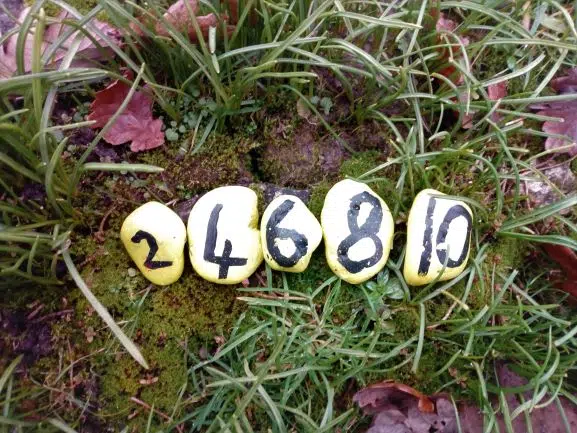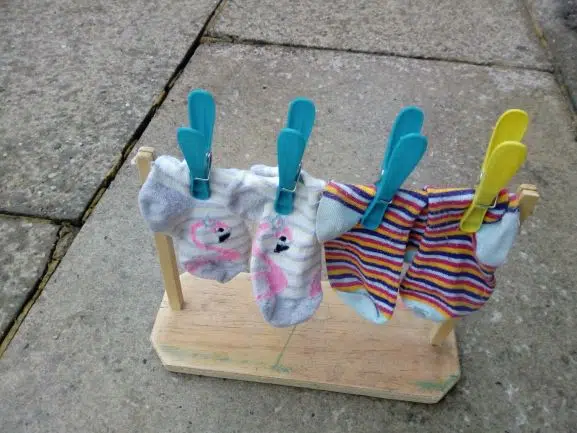Teaching children to count by 2s is a multi-step process. I have split it into three main phases, how to start, how to develop the skill, and how to practice it once children have mastered the process.
I have tried out all the following strategies over the last ten years of my teaching career. Over the last couple of years, I have also taught these strategies to hundreds of teachers at live workshops.
The best activities to teach children to count by 2s are the following:
| Level | Activity |
| Beginner | March Counting |
| Action Counting | |
| Songs | |
| Online Songs | |
| Chants | |
| Follow The Wand | |
| Action Counting | |
| Medium | Count The Body Parts |
| Pair Up Gloves On A Line | |
| Hand Print Splat Painting | |
| Number Line Jumping | |
| Number Line Counting | |
| Counting Things That Come In Twos | |
| More Difficult | Number Stones |
| Order Objects | |
| Rote Count Chanting | |
| Rote Counting Partners | |
| Count Round The Circle | |
| Shark Attack! |
Start to teach children to count by 2s with songs and chants, and fun ways of rote counting. Then progress to counting in 2s practically in a range of ways. Finally, consolidate the process by counting in calculating in 2s more fluently.
That’s the process in a nutshell, and I’ll now add a bit more meat to the bone.
Luckily, humans are built around twos. We have two arms, two legs, two eyes, and all that kind of thing. This really helps the process of teaching to count by 2s.
I have worked out my all-time favorite 15 activities for teaching counting by 2s, and I have set them out in order, from easiest to most difficult.
So, here are the activities themselves:

For Beginners – Getting Started With Counting By 2s
The best way to start children off with counting by 2s is to get them doing some of the following:
- Singing songs
- Trying out chants
- Playing rote counting games
The more multisensory you make it then the more fun they will have, and this will lead to a much better foundation to work from following this.
There has been research on rote counting and its fundamental importance in early number skills. (Source)
Here are some super easy games to get started:
1. March Counting
This is a great way to start!
Get the children up on their feet. You are all going to march together. Swing your arms, and encourage them to get those knees up!
We are going to count at the same time as marching – 1, 2, 3 etc. However, when everyone’s right foot hits the floor we are going to say the number, and when their left foot hits the floor, we are going to be silent, and just say the number in our head.
So it will look a bit like – left foot: silently mouth ‘1’, right foot: say, ‘2’, left foot: silent ‘3’, right foot: ‘4’.
Keep going like this until the children can count no further.
This is also a great game for simple rote counting (find out the ultimate 17 rote counting games here).
2. Action Counting
This is basically the same concept as march counting.
You pick some kind of movement, and do the same counting strategy as with march counting – the odds are silent, and say the even numbers.
Some good moves to try include:
- Arms up then down
- Jump
- Hop
- One arm out to one side, then the opposite arm out on the other side
Be as creative as you want.
If the children can think of their own ideas, then brilliant! That is exactly what you want.
3. Songs
Songs are a fantastic way of teaching pretty much anything, (check out some fantastic math songs for counting here), and counting by 2s is no exception.
Simple counting songs are quite easy to make up, to be honest. Here is one I created to the music of Twinkle Twinkle:
2, 4, 6, 8, 10, that’s right!
Count by day and count by night!
So simple, but a good way to get them started.
4. Online Songs
There are lots of great animations and counting videos on YouTube. This is one that I have used quite a lot:
Very catchy, and really gets them involved.
A top tip is to encourage the children to try to show the numbers on their fingers as they are singing. This is easier said than done, but this again activates more parts of the brain.
5. Chants
Here is a chant that children really enjoy. It is a bit like a cheerleader chant, and it goes:
2, 4, 6, 8,
Who do we appreciate!
8, 6, 4, 2,
We appreciate me and you!
This chant has the added bonus of counting both forwards and backwards in 2s.
Chants like this deeply embed rote counting because they activate multiple parts of our brains at the same time.
6. Follow The Wand
This is an old-school activity, that has had a powerful impact for generations.
Have some kind of magic wand for this. It could be a ‘real’ magic wand, or even a stick with some material wrapped around it.
This activity is similar to the march counting.
Have the children sitting facing you. Have the magic wand in your hand on your lap, with the end of the wand pointing vertically upwards.
You are going to start pointing the wand first to the left, and then to the right. The children are going to count as you do this.
When you point the wand to the left, they are going to say nothing. When you point to the right they will say the number.
So it will sound a bit like: ‘…2…4…6…8…10’
This is a great way of beginning to skip count and starting to understand what that means.
7. Action Dancing
Put on some pumping music for this one, and get the children on their feet!
It’s the same kind of idea as the action dancing.
Pick a simple dance move, ideally one with two movements. Count as you dance. For the first movement say nothing. For the second, say the number.
So it might be – jive to the right (silent ‘1’), jive to the left – ‘2!’
Hours of fun!
Medium Level Difficulty
When children have a got a simple foundation built, and have played around at counting by 2s, it is time to take it to the next level.
The idea now is to begin problem-solving and thinking in twos.
The following activities give them lots of opportunities to begin to apply the rote counting that they have now started to develop.
8. Count The Body Parts
This is a fun listening game, as well as being great for counting. As I mentioned before, we are lucky that our bodies have lots of opportunities for counting in twos.
All the children that you have working with you stand up to start with.
Ask a simple question, something like, ‘Who likes eating tomatoes?’
If children like eating tomatoes then they stay stood up. If they don’t, then they sit down.
Then you say something like, ‘How many legs are still standing up?’
The children try to count the legs of the children standing up. Either count in 1s (the easy way) or if anyone is able to count in 2s, then that is exactly what you want.
Model how to count in 2s, and see if they can join in.
You can also count:
- Eyes
- Ears
- Arms
- Hands
Keep going, asking a range of questions, with a few children (normally) sitting down each time.
Games like this are also great for practicing one-to-one correspondence (find out what that is, and the best ways of teaching it here).
9. Pair Up Socks On A Clothes Line
Many children really enjoy pegging things up on lines! It’s so simple, but such a natural game to play (for many more math clothes line games, check out these 17 games).
You need some kind of clothesline for (just a piece of string hung up somewhere would be fine). You also need an assortment of pairs of socks.
Quite simply, they try to pin up the socks in pairs next to each other. Then try to count how many you’ve got. Again, they will often try to count in 1s, but model counting in 2s.

You could play a game where you roll a dice. Say you get a 3, try to put 3 pairs of socks up on the line. How many socks are there?
10. Hand-Print Splat Painting
This is incredible fun, this activity.
You just need some sort of giant piece of paper – something like wallpaper would be great. You also require some paint in bowls or on plates.
The children put both hands into the paint, and then start making hand prints, with both hands splatting down next to each other at the same time. If they are able to rote count in twos at this point, then go for it as you splat – 2, 4, 6 etc.
If not, then just practice counting at the end, when they have done lots of splatting.
11. Number Line Jumping
Some kind of big number line on the floor is required for this. It could be drawn in chalks – that would be the simplest method.
Or if you already have one painted on the ground, or some other kind of number line, then great – use that.
One child starts at zero. Basically, the idea is that the odd numbers are now lava! You can’t touch them.
So you have to try to jump from 0 to 2. Then 2 to 4, and keep going like that.
As you land on a number, try to say it.
A simple way to explain the game is just that you jump over one number every time.
You can jump both forwards and backwards, and so practice different counting by 2s skills.
12. Number Line Counting
This is the mini version of the number line jumping game above.
Have some kind of smaller number line, probably on a wall, or drawn on a board.
Have something to point at the number line, like a wand or something similar.
Point the wand at zero, then jump to 2, then jump over the top of 3 to land on 4, and so on. The children say the number that they land on each time.
This makes the process of counting by 2s very visual.
Also, number lines will often play a big part in learning about numbers for many years, and it is good to learn how to use them for this skill.
13. Counting Things That Come In Twos
Pointing out things in the children’s immediate environment that naturally come in twos, is a good way to get them to apply the skill of counting in real life.
For example, welly-boots on a stand will usually be standing in twos. Try to count them.
Some plants may have two leaves or berries that grow in twos.
A row of sunglasses – count the lenses.
Just see what you can find and take advantage of it.
More Difficult Strategies – Practising The Skill
When children are able to count more confidently in twos, then it is time to practice the skill in a range of contexts.
Some good ideas include:
14. Number Stones
These are a really beautiful and natural resource.
All you need for this are some pebbles of some description, which you can buy very cheaply from hardware stores or builder’s yards.
Either write on numbers in 2s in permanent marker, or for a more long-lasting effect, then paint them on with acrylic paint.
These become a fantastic resource for children to try to place in order, counting in 2s as they go.
You can find a full repertoire of other number stone games in this post that I wrote.
15. Order Objects
This is a similar idea to ordering the number of stones.
You have some kind of resource that has numerals on them – 2, 4, 6, 8, etc (go as high as you want for your children).
Some good things to write numbers on would be:
- Wood slices
- Shot glasses
- Leaves
- Balls
Then the children quite simply try to put them in order.
16. Rote Count Chanting
After children have become good at counting by 2s in songs and dances, then the next step is to simplify this slightly, and just get them straight chanting the numbers.
It’s simple! Just sit down somewhere, and practice saying, ‘2, 4, 6, 8, 10, 12…’ all together at the same time.
17. Rote Counting Partners
The children sit in pairs, facing each other.
One child is going to say, ‘2’, and then the other says, ‘4.’ The next one says, ‘6’, and just keep going like this, counting back and forth between you.
This is a fun way of cooperating and counting at the same time.
18. Count Round The Circle
The children sit in a circle for this one.
It’s a simple idea – the first person in the circle is going to say ‘two’. Then the person sitting next to them will say, ‘four’. Then next says, ‘six’, and so on around the circle.
This counting game is just one of many you will find in this article about rote counting.
19. Shark Attack – Group Into Twos
Have some circles drawn on the ground in chalk for this game. Have a line of circles each about 1 yard wide, and about 6 feet from each other – all in a row.
These are the caves to hide from the sharks!
The children are now ‘swimming’ in shark-infested water. Just get them to move about the space in different ways.
Whenever you shout, ‘Shark!’ they are going to run to the ‘caves’. The rule is that two people must stand on a cave. If you are just one person (or three) then you are out!
Once the children are standing in twos on the caves, they are going to count in 2s. The first pair in the row of caves are going to say ‘two’. Then the next will say ‘four’. Keep going, counting in twos down the line.
Final Thoughts
By following the above process step by step, counting by 2s is a skill that most children should be able to absorb. It is good fun, and also a great opportunity to use songs, movements, dances, and a range of exciting resources.
If you’ve enjoyed this article, then another one you will like is Math Circle Time Games – The Ultimate 20 Ideas.
